
Kitchen Rebuild
We built our house 22 years ago, and everything is a little tired now. So, directed by my wife, Lynndy (She Who Must Be Obeyed), I have set about updating the kitchen, which is 3 years older than the house, having been saved from the house we knocked down to build this one.
The
original 25-year old kitchen ...
The layout is going to change only a little - mainly to accommodate a new and wider fridge-freezer ….. the old fridge-freezer was dying. It was 35 years old. We’d had it all our marriage. It needed to be replaced. The new fridge-freezer was wider and a touch taller than the old. The problem was that the alcove into which it was built had a cabinet above, and changing this cabinet meant changing the door … and it would not be possible to match the Tasmanian Oak to blend in with all the other cabinet doors and drawers. I think that Lynndy planned this all along.
So we needed new cabinet doors and drawer fronts … and then it became a new countertop in granite … and then a more modern range hood.
Lynndy
wants modern and light. And so the cabinet design will be Shaker and
in Hard Maple (from the USA).
Building the doors
I
thought that I would post a few pictures here of the method I am
using to build the doors - not because it is different or because it
is striking (it is neither of these since the design is really
simple) - but because someone else may find this useful. Anyway we
all like looking at the tools of others, right? ![]()
Those
who know me recognise that this build is a departure from my usual
handtool approach. I do use power tools, and have been around them
for 30-40 years. I have a pretty full compliment in my shop at home,
and they do get used. It's just that I prefer using handtools once
the roughing out is done. This time, however, there was no way I
could see myself building around 25 doors full of M&T joints with
tenon saw and mortice chisel. We'd like the job done sooner rather
than later. So I invested in a Festool DF500 Domino.
Here
are some of the hand power tools I am using ..
Incidentally,
the ROS is a Festo ET2E, and the router is an Elu 177e ... which
should tell you how long I have had them (yes, they are around 25
years old) ...
Not to forget ...
Other
tools include a Veritas BUS for smoothing the frames (the sander was
used on the panels with Mirka Abranet up to 400 grit) ...
The
ends of boards needed to be perfectly square. This is the Veritas
Shooting Plane on a Stanley #52 shooting board ...
I
managed to get in a decent stock of rough sawn 1" and 2"
thick x 10" wide Hard Maple boards ..

The
boards were resawn on my Hammer 4400 and finished on a A3-31 to
panels 1/4" thick or frames 3/4" thick ...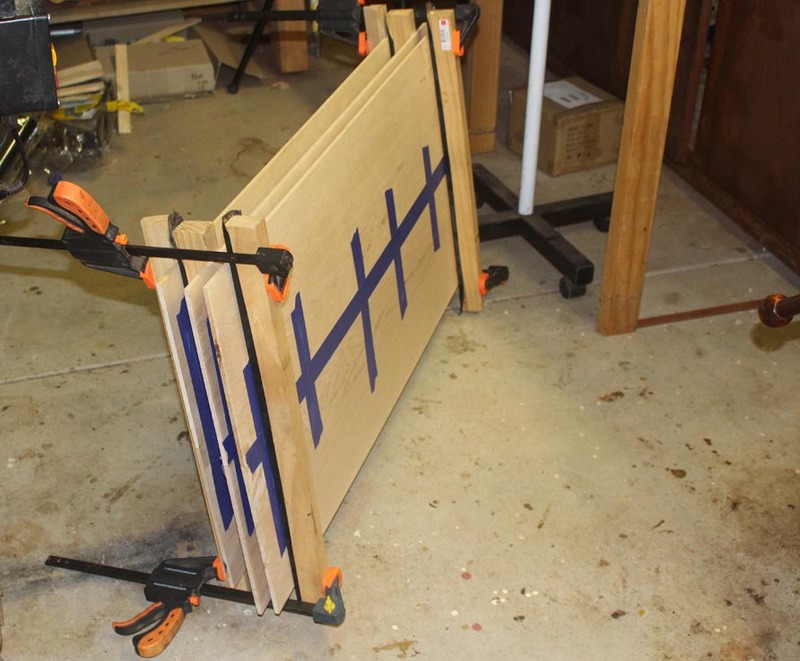
The
panels are all bookmatched, and the joins pulled together with blue
tape. No clamps required.
These
are for the frames. I can build about 5 doors at a time.
The
next step is to saw the pieces to length, and then Domino the frame
together. This is a first for me (Domino virgin). How to hold the
pieces? I've seen some of the fancy Festool benches and clamps. My
system seems so much easier.
Push the board against the
dogs on my bench, and use a single, centred Veritas hold down to
clamp them firmly ...

This
makes it possible to Domino each end without resetting the
board.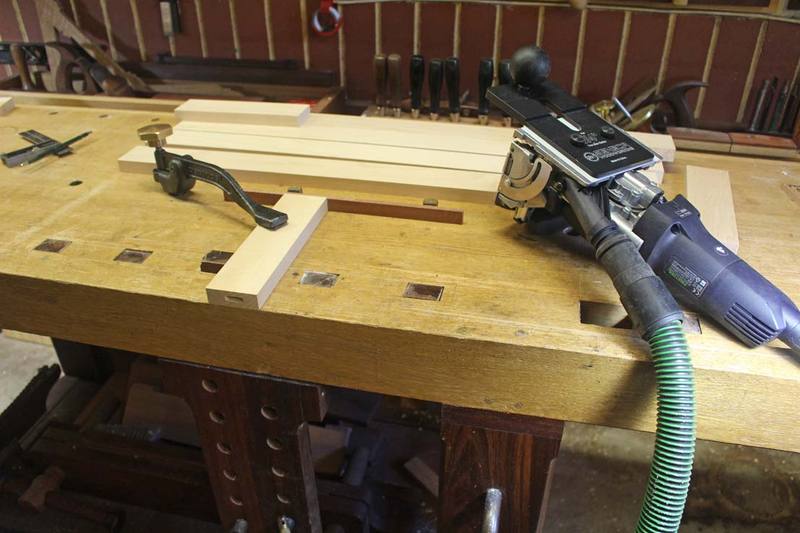
The
parts are pushed together for a dry fit, clamped against dogs, and
raised higher on MDF spacers (for the router bit to fit) ..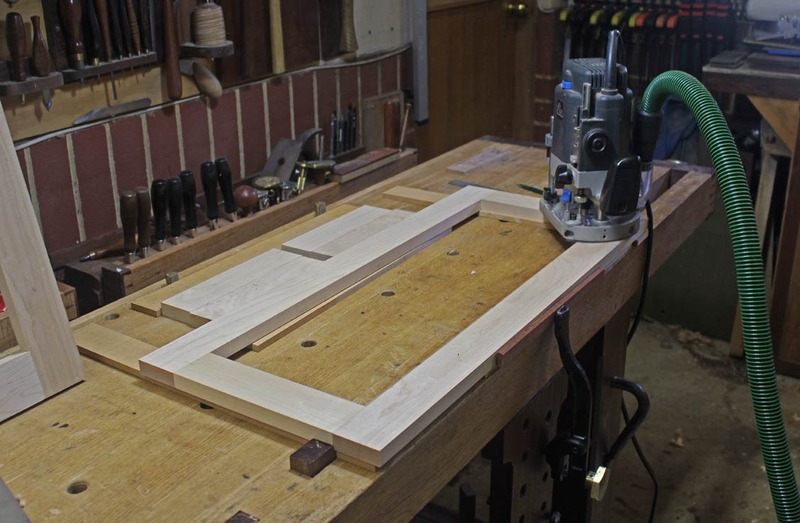
A
1/4" grooving bit is used to route out the 1/4" deep groove
for the panel ...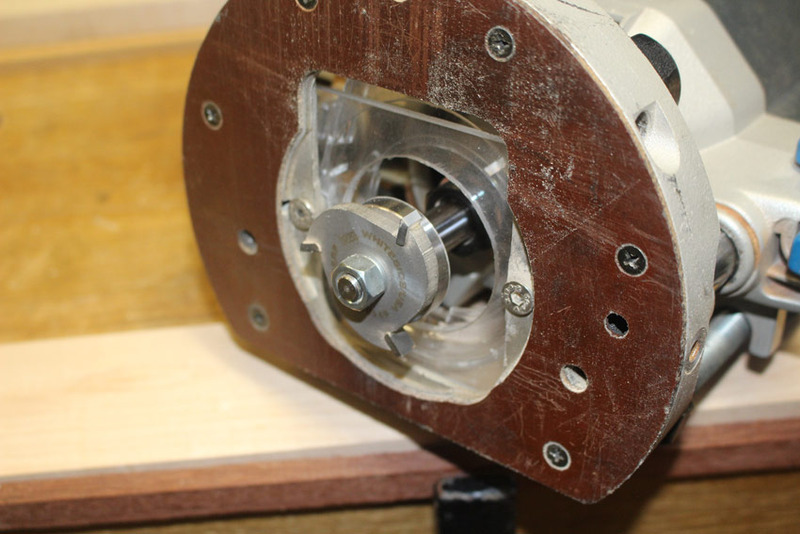
This
leaves an uncut corner ...
The
choice is to use a smaller bearing, which will cut deeper in the
corner. I tried this on one door, however I found that the process of
swapping the bearings out could cause the setting to change
slightly.
Consequently, I decided to chop out the corners with
a mortice chisel. This proved to be faster than setting up the router
and re-routing the corners ...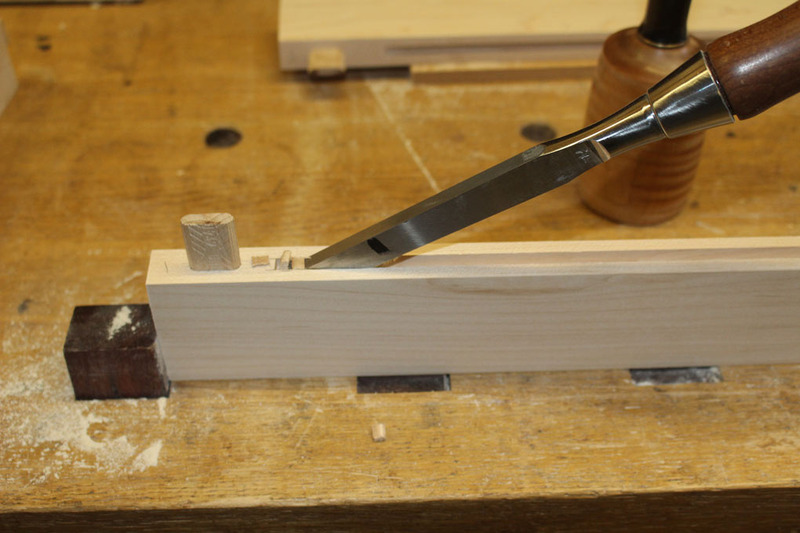
The
inside edges arris of the frame were broken with a sander
...
Next-to-last,
the panels could be cut to size and fitted to the frames. Allowance
is made for expansion.
Finally, the outside arrises are
chamfered with a block plane ...
Here
is an example at this stage. New on the left, old on the right
..
Just
dry fitting. No finish. That will be done later. Hinges and hardware
still to be fitted. Lots to do.
Hand finishing water-based poly
The
decision was made to use Hard Maple for the kitchen doors and drawer
fronts because the wood was light in colour and the figure was
gentle. With very little experience in working with this wood
(imported from the USA), I decided to use a USA-made finish, since
this appeared to be recommended as the best way to retain its light
colour. That's where I ran into the first hurdle.
General
Finishes water-based poly received the top rating a few years ago in
a Fine Woodwork magazine comparison, however it is best sprayed, and
I do not have spray equipment.
I looked into brushing on
the finish. General Finishes recommend using a foam brush. However,
all the reviews and videos I examined complained of brush marks and
streaks in the finish, whether by the best brush or foam. This is
partly due to water-based finishes drying rapidly. They set in
minutes - sometimes seconds! - and there is no time for the finish to
be self-levelling.
To date, my main finishes have been oils
and shellac, which I have applied with a rag. I would have liked to
have used shellac here, but it is just not durable enough in a
kitchen, which will be wiped down frequently. Still, my experience is
in wiping a finish, and so I tried this with the GF. It went on well,
and it showed promise. The only fly in the ointment was the
water-based finish raised the grain, and this would require that the
finish was sanded again.
I decided that I would use a
dewaxed, white shellac as a sealer prior to wiping on the poly. My
choice here is Ubeaut White Shellac, which is concentrated. It was
diluted 50-50 with alcohol (methylated spirits).
For rags I
used microfibre, and grey Scotch mesh smoothed the surface between
coats.
This
is a door pre-finish ...
Pulled
apart. Every piece is carefully marked for mating and orientation
...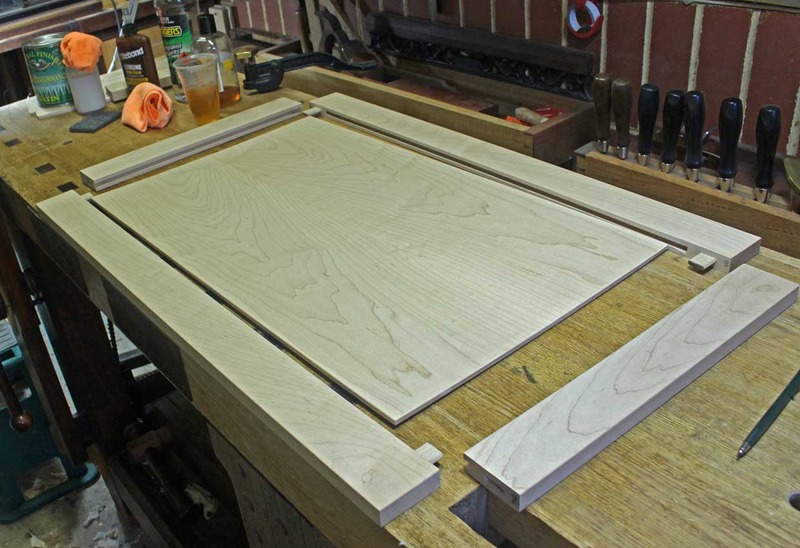
Each
surface was given two coats of shellac (with the grain) ...
..
followed with a rub down (with the grain) ...

The
shellac does colour the wood, but very slightly - far less than
expected from its darkish amber. It dries quickly, and within minutes
of each coat one can move onto the next.
Now it is the turn of
the poly. It is white in the decanted bottle. but goes on
clear.
The
finish is a little sticky, and it is drying fast. I apply it as if it
were polish and I was polishing the surface of the wood – it is
almost a case of rubbing off
the finish
rather than rubbing it on. You can do so in small circles, but you
must finish (as it dries) by only rubbing along the grain. Using
raking light, look for any streaks. Simply rub them out.
Once
dry, use the grey mesh to rub the surface with the grain. It not only
removes any streaks, which it blends all together, but it seems to
raise a shine.
It takes at least 2-3 layers before the shine
becomes apparent. The poly slowly builds in thickness. Polishing it
as done here only adds a thin coating on each occasion. Then suddenly
it is there ..
I
stop after 5 coats.
Now
it is time to glue the frame together. The panel floats inside the
frame ...
A note on the glues: I used Titebond lll for the
bookmatched panel as it is water resistant. I used Titebond Liquid
Hide Glue on the Domino mortice-and-tenon joints as this is
reversible and unlikely to affect the finish.
How
much colour change did the finishes add? Here is the completed panel
along with a planed but otherwise unfinished board ...
Installing the doors
I
have been reading a marvellous book by Nancy Miller, "Making
Things Work". This is the story of her life as a cabinetmaker. I
really recommend this to any aspiring amateur seeking to turn pro. I
think I shall remain a happy weekend warrior.
One of the
paragraphs that leapt off the page was this .. "You
might imagine that full-overlay doors and drawer faces make for the
simplest-possible installation. They do - when these elements have
enough space between them to make any inconsistencies in the margins
unnoticeable...... each adjustment of one door or drawer in any of
its three planes affected every other one nearby. Not only did the
margins need to be consistent, parts in such close proximity must
also be in plane. For example, if the right edge of one drawer
protruded even just a little relatove to its neighbor, the neighbor,
too, had to be adjusted ... ".
I
think Nancy wrote this to mock me as I began installing doors and
drawers this weekend.
The challenge - getting the corner
pantry double door to hang with good gaps ... aaahh! The family
stayed well away ... 
All
the other doors were, thankfully, much easier using Grass Euro
hinges.

I
cannot wait to get back to building furniture!
Regards from Perth
Derek
December 2016 – April 2017